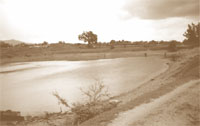Neglected structures
 These systems were evolved keeping in mind the unique topography of the region. Earlier, kings used to give agricultural lands to those maintaining tanks as incentives. Today, most of these structures are in a dilapidated condition, and in some cases have simply vanished.
These systems were evolved keeping in mind the unique topography of the region. Earlier, kings used to give agricultural lands to those maintaining tanks as incentives. Today, most of these structures are in a dilapidated condition, and in some cases have simply vanished.
bandh: A traditional pond that is usually located in the lower ridges. The water conserved is used for drinking and bathing purposes. Almost every village and town of western Orissa has such ponds.
munda: This semi-circular structure is found on the upper ridge of the village and just above the village's expanse of agricultural fields. It is used for percolation purposes and to retain the moisture level of the field. Water running away from upper areas enters this structures and the semi-circular embankment stops it from running away. It resembles the Johad and each village has anywhere between five to 10 structures.
kata: A variation of the Munda, it collects water from a larger catchments area. It has embankments on three sides. This is also used for percolation but in case of rainfall failure, the embankment is breached for irrigation purposes. In its catchment areas, farmers grow paddy and a second crop of pulses using the moisture content.
chahals: Rectangular tanks dug within paddy fields but without any embankments. This water is used when there is insufficient water for irrigation.
sagar: A structure measuring around eight hectares and is situated just beneath hills and mountains. It catches rainwater gushing from these hills. This is a community-owned structure and kings used to give incentive for such works.
Related Content
- Towards the integration of nutrition and gender in the agriculture system of Ethiopia
- Extreme weather events: How hard lessons strengthen resilience against the next big event
- The challenge of agricultural pollution: evidence from China, Vietnam, and the Philippines
- Zika: A scourge in urban slums
- The role of inequality in climate-poverty debates
- The second report on the State of the World’s Animal Genetic Resources for Food and Agriculture
